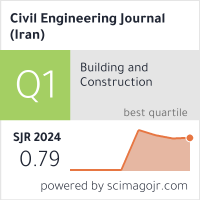Performance of Bio Concrete by Using Bacillus Pasteurii Bacteria
Downloads
In concrete, cracking is a common phenomenon due to its relatively low tensile strength"Ž "Ž, which occurs due to external loads and imposed deformations"Ž"Ž. The main research objective is to create a kind of self-healing concrete by employing mineral producing bacteria Bacillus pasteurii"Ž to locate the rift in the most favourable circumstances for autogenous healing to take place. Self-healing concrete containing bacteria has been generated for this study through the application of bacterial self-healing elements as "Žspores "Žand nutrients with different percentages of bacteria ranging from (10% - 25%) as a replacement of mixing water is added at the time of pouring. The bacteria influence was observed by Scanning Electron Microscope (SEM) and with Energy "ŽDispersive X-ray Spectrometer. The mechanical properties and durability of a thirty-five mixture were "Žexamined. The optimal blending content proportion was "Ž10SF20BC, which showed an increment in compressive strength and flexural strength compared to the control mixture "Žto "Žreach 79.16%, 50% respectively and 24.38% enhancement in sulfate resistance. The highest percentage of calcium carbonate precipitations was "Ž9.49% of a weight of "Žmixtures "Želements, which, in turn, revealed the highest area repair rate, which was able to fill the "Žcrack with widths leads to 0.80 mm.
Downloads
[2] Yang, Yingzi, Michael D. Lepech, En-Hua Yang, and Victor C. Li. "Autogenous Healing of Engineered Cementitious Composites Under Wet–dry Cycles.” Cement and Concrete Research 39, no. 5 (May 2009): 382–390. doi:10.1016/j.cemconres.2009.01.013.
[3] Amer Algaifi, Hassan, Suhaimi Abu Bakar, Abdul Rahman Mohd. Sam, Mohammad Ismail, Ahmad Razin Zainal Abidin, Shafinaz Shahir, and Wahid Ali Hamood Altowayti. "Insight into the Role of Microbial Calcium Carbonate and the Factors Involved in Self-Healing Concrete.” Construction and Building Materials 254 (September 2020): 119258. doi:10.1016/j.conbuildmat.2020.119258.
[4] Vempada, Srinivasa Reddy, S. Sunil Pratap Reddy, MV Seshagiri Rao, and Ch Sasikala. "Strength enhancement of cement mortar using microorganisms-an experimental study." Int J Earth Sci Eng 4 (2011): 933-936.
[5] Afifudin, Habulat, Mohd Saman Hamidah, Hussain Noor Hana, and Kartini Kamaruddin. "Microorganism Precipitation in Enhancing Concrete Properties.” Applied Mechanics and Materials 99–100 (September 2011): 1157–1165. doi:10.4028/www.scientific.net/amm.99-100.1157.
[6] Nain, Nidhi, R. Surabhi, N.V. Yathish, V. Krishnamurthy, T. Deepa, and Seema Tharannum. "Enhancement in Strength Parameters of Concrete by Application of Bacillus Bacteria.” Construction and Building Materials 202 (March 2019): 904–908. doi:10.1016/j.conbuildmat.2019.01.059.
[7] Jacobsen, Stefan, and Erik J. Sellevold. "Self-Healing of High Strength Concrete after Deterioration by Freeze/thaw.” Cement and Concrete Research 26, no. 1 (January 1996): 55–62. doi:10.1016/0008-8846(95)00179-4.
[8] Reinhardt, Hans-Wolf, and Martin Jooss. "Permeability and Self-Healing of Cracked Concrete as a Function of Temperature and Crack Width.” Cement and Concrete Research 33, no. 7 (July 2003): 981–985. doi:10.1016/s0008-8846(02)01099-2.
[9] Bang, S. S., J. J. Lippert, U. Yerra, S. Mulukutla, and V. Ramakrishnan. "Microbial Calcite, a Bio-Based Smart Nanomaterial in Concrete Remediation.” International Journal of Smart and Nano Materials 1, no. 1 (February 17, 2010): 28–39. doi:10.1080/19475411003593451.
[10] Jonkers, H. M., and E. Schlangen. "Towards a sustainable bacterially-mediated self healing concrete." In Proceedings of 2nd International Conference on Self-Healing Materials, Chicago. (2009).
[11] Jonkers, Henk M. "Self Healing Concrete: A Biological Approach.” Self Healing Materials (2007): 195–204. doi:10.1007/978-1-4020-6250-6_9.
[12] Su, Yilin, Jianhang Feng, Peng Jin, and Chunxiang Qian. "Influence of Bacterial Self-Healing Agent on Early Age Performance of Cement-Based Materials.” Construction and Building Materials 218 (September 2019): 224–234. doi:10.1016/j.conbuildmat.2019.05.077.
[13] Jiang, Lu, Guanhua Jia, Chen Jiang, and Zhu Li. "Sugar-Coated Expanded Perlite as a Bacterial Carrier for Crack-Healing Concrete Applications.” Construction and Building Materials 232 (January 2020): 117222. doi:10.1016/j.conbuildmat.2019.117222.
[14] Schlangen, E. "Self-healing phenomena in cement-based materials." RILEM (2005).
[15] Joseph, C., "Experimental and Numerical Study of the Fracture and Self-Healing of Cementitious Materials” PhD thesis: Cardiff University, (2008).
[16] Ter Heide, N., E. Schlangen, and K. Van Breugel. "Experimental study of crack healing of early age cracks." In Proceedings Knud Hí¸jgaard conference on Advanced Cement-Based Materials, Technical University of Denmark. (2005).
[17] Manikandan, A. T., and A. Padmavathi. "An experimental investigation on improvement of concrete serviceability by using bacterial mineral precipitation." International Journal of Research and Scientific Innovation (IJRSI) 2, no. 3 (2015): 48.
[18] Ghosh, Pratanu, and Quang Tran. "Correlation Between Bulk and Surface Resistivity of Concrete.” International Journal of Concrete Structures and Materials 9, no. 1 (November 21, 2014): 119–132. doi:10.1007/s40069-014-0094-z.
[19] Biglari, Moein, Amirhosein Sheykh Azami, Ali Kahidan, Ehsan Ghafari, and Mohammad Ali Ghasemi. "Investigating the Effects of Cement Type and W/C Ratio on the Concrete Corrosion Using the Electrical Resistance Assessment Method.” Civil Engineering Journal 4, no. 8 (August 31, 2018): 1897. doi:10.28991/cej-03091124.
[20] Ramachandran, Santhosh K., V. Ramakrishnan, and Sookie S. Bang. "Remediation of concrete using micro-organisms." ACI Materials Journal-American Concrete Institute 98, no. 1 (2001): 3-9. doi:10.14359/10154.
[21] V. Ramakrishnan, S. S. Bang, K.S. Deo, "A novel The technique for repairing cracks "high-performance concrete using bacteria, Proc. Int. Conf. on High-Performance High Strength Concrete. "Perth, Australia, (1998): 597–618.
[22] Andalib, Ramin, Muhd Zaimi Abd Majid, Mohd Warid Hussin, Mohanadoss Ponraj, Ali Keyvanfar, Jahangir Mirza, and Han-Seung Lee. "Optimum Concentration of Bacillus Megaterium for Strengthening Structural Concrete.” Construction and Building Materials 118 (August 2016): 180–193. doi:10.1016/j.conbuildmat.2016.04.142.
- Authors retain all copyrights. It is noticeable that authors will not be forced to sign any copyright transfer agreements.
- This work (including HTML and PDF Files) is licensed under a Creative Commons Attribution 4.0 International License.![]()















